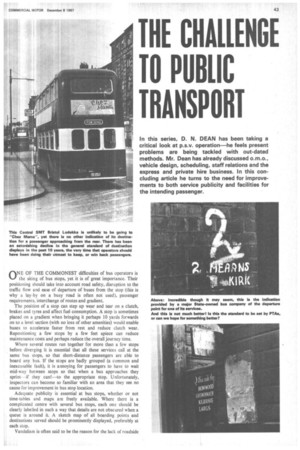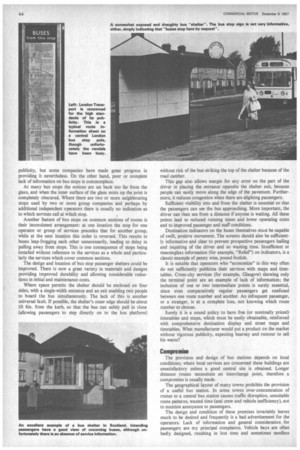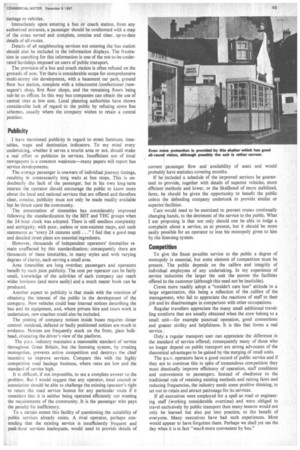THE CHALLENGE TO PUBLIC TRANSPORT
Page 45

Page 46

Page 47

If you've noticed an error in this article please click here to report it so we can fix it.
ONE OF THE COMMONEST difficulties of bus operators is the siting of bus stops, yet it is of great importance. Their positioning should take into account road safety, disruption to the traffic flow and ease of departure of buses from the stop (this is why a lay-by on a busy road is often not used), passenger requirements, interchange of routes and gradient.
The position of a stop can step up wear and tear on a clutch, brakes and tyres and affect fuel consumption. A stop is sometimes placed on a gradient when bringing it perhaps 10 yards forwards on to a level section (with no loss of other amenities) would enable buses to accelerate faster from rest and reduce clutch wear. Repositioning a few stops by a few feet apiece can reduce maintenance costs and perhaps reduce the overall journey time.
Where several routes run together for more than a few stops before diverging it is essential that all these services Gall at the same bus stops, so that short-distance passengers are able to board any bus. If the stops are badly grouped (a common and inexcusable fault), it is annoying for passengers to have to wait mid-way between stops so that when a bus approaches they sprint--if they can!—to the appropriate stop. Unfortunately, inspectors can become so familiar with an area that they see no cause for improvement in bus stop location.
Adequate publicity is essential at bus stops, whether or not time-tables and maps are freely available. Where there is a complicated centre with several bus stops, each one should be clearly labelled in such a way that details are not obscured when a queue is around it. A sketch map of all boarding points and destinations served should be prominently displayed, preferably at each stop.
Vandalism is often said to be the reason for the lack of roadside publicity, but some companies have made great progress in providing it nevertheless. On the other hand, poor or complete lack of information on bus stops is commonplace.
At many bus stops the notices are set back too far from the glass, and when the inner surface of the glass mists up the print is completely obscured. Where there are two or more neighbouring stops used by two or more group companies and perhaps by additional independent operators there is usually no indication as to which services call at which stop.
Another feature of bus stops on common sections of routes is their inconsistent arrangement: at one location the stop for one operator or group of services precedes that for another group, while at the next location this order is reversed. This results in buses leap-frogging each other unnecessarily, leading to delay in pulling away from stops. This is one consequence of stops being installed without reference to the services as a whole and particularly the services which cover common sections.
The design and location of bus stop passenger shelters could be improved. There is now a great variety in materials and designs providing improved durability and allowing considerable reductions in initial and maintenance costs.
Where space permits the shelter should be enclosed on four sides, with a single-width entrance and an exit enabling two people to board the bus simultaneously. The lack of this is another universal fault. If possible, the shelter's outer edge should be about lft 6in. from the kerb, so that the bus can safely pull in close (allowing passengers to step directly on to the bus platform) without risk of the bus striking the top of the shelter because of the road camber.
This gap also allows margin for any error on the part of the driver in placing the entrance opposite the shelter exit, because people can easily move along the edge of the pavement. Furthermore, it reduces congestion when there are alighting passengers.
Sufficient visibility into and from the shelter is essential so that the passengers can see the bus approaching. More important, the driver can then see from a distance if anyone is waiting. All these points lead to reduced running times and lower operating costs and to improved passenger and staff conditions.
Destination indicators on the buses themselves must be capable of swift, positive movement. The screens should also be sufficiently informative and clear to prevent prospective passengers hailing and inquiring of the driver and so wasting time. Insufficient or meaningless information (for example, "Relief') on indicators, is a classic example of penny wise, pound foolish.
It is notable that operators who "economize" in this way often do not sufficiently publicize their services with maps and timetables. Cross-city services (for example, Glasgow) showing only the terminal point are an example of lack of information; the inclusion of one or two intermediate points is surely essential, since even comparatively regular passengers get confused between one route number and another. An infrequent passenger, or a stranger, is at a complete loss, not knowing which route number to choose.
Surely it is a sound policy to have free (or nominally priced) timetables and maps, which must be easily obtainable, reinforced with comprehensive destination display and street maps and timetables. What manufacturer would put a product on the market without vigorous publicity, expecting hearsay and rumour to sell his wares?
Compromise
The provision and design of bus stations depends on local conditions; where local services are concerned these buildings are unsatisfactory unless a good central site is obtained. Longer distance routes necessitate an interchange point, therefore a compromise is usually made.
The geographical layout of many towns prohibits the provision of a useful bus station. In some towns over-concentration of routes to a central bus station causes traffic disruption, unsuitable route patterns, wasted time (and crew and vehicle inefficiency), not to mention annoyance to passengers.
The design and condition of these premises invariably leaves much to be desired and frequently is a bad advertisement for the operators. Lack of information and general consideration for passengers are my principal complaints. Vehicle bays are often badly designed, resulting in lost time and sometimes needless damage to vehicles.
Immediately upon entering a bus or coach station, from any authorized entrance, a passenger should be confronted with a map of the areas served and complete, concise and clear, up-to-date details of all routes.
Details of all neighbouring services not entering the bus station should also be included in the information displays. The frustration in searching for this information is one of the not-to-be-underrated hardships imposed on users of public transport.
The provision of a bus and coach station is often refused on the grounds of cost. Yet there is considerable scope for comprehensive multi-storey site development, with a basement car park, ground floor bus station, complete with a tobacconist /confectioner /newsagent's shop, first floor shops, and the remaining floors being sub-let as offices. In this way bus companies can obtain the use of central sites at low cost. Local planning authorities have shown considerable lack of regard to the public by refusing some fine schemes, usually where the company wishes to retain a central position.
Publicity
I •have mentioned publicity in regard to street furniture, timetables, maps and destination indicators. To my mind every undertaking, whether it serves a tourist area or not, should make a real effort to publicize its services. Insufficient use of local newspapers is a common weakness—many papers will report bus service developments.
The average passenger is unaware of individual journey timings, resulting in unnecessarily long waits at bus stops. This is undoubtedly the fault of the passenger, but in his own long-term interest the operator should encourage the public to know more about the local and national services that are offered and therefore clear, concise, publicity must not only be made readily available but be thrust upon the community.
The presentation of timetables has considerably improved following the standardization by the BET and THC groups when the 24-hour clock was adopted. There is still needless complexity and ambiguity, with poor, useless or non-existent maps, and such statements as "every 24 minutes until. .." I feel that a good map and detailed street plans are essential ingredients.
• However, thousands of independent operators' timetables remain unaffected by this standardization; consequently there are thousands of these timetables, in many styles and with varying degrees of clarity, each serving a small area.
Area timetables are long overdue; passengers and operators benefit by such joint publicity. The cost per operator can be fairly small, knowledge of the activities of each company can reach wider horizons (and more easily) and a much neater book can be produced.
Another aspect to publicity is that made with the intention of obtaining the interest of the public in the development of the company. New vehicles could bear internal notices describing the bus and its equipment, and, where private hire and tours work is undertaken, new coaches could also be included.
The posting of company notices inside buses requires closer control: outdated, defaced or badly positioned notices are much in evidence. Notices are frequently stuck on the front, glass bulkhead, obscuring the driver's view of the platform.
The p.s.v. industry maintains a reasonable standard of service throughout Great Britain, but the licensing system, by creating monopolies, prevents active competition and destroys the chief incentive to improve services. Compare this with the highly competitive road haulage business, where rates are low and the standard of service high.
It is difficult, if not impossible, to see a complete answer to the problem. But I would suggest that any operator, local council or association should be able to challenge the existing operator's right to retain the road service licence for any particular route if it considers that it is neither being operated efficiently nor meeting the requirements of the community. It is the passenger who pays the penalty for inefficiency.
To a certain extent this facility of questioning the suitability of public services already exists. A rival operator, perhaps con tending that the existing service is insufficiently frequent and peak-hour services inadequate, would need to provide details of current passenger flow and availability of seats and would probably have statistics covering months.
If he included a schedule of the improved services he guaranteed to provide, together with details of superior vehicles, more efficient methods and lower, or the likelihood of more stabilized, fares, he should be given the opportunity to benefit the public unless the defending company undertook to provide similar or superior facilities.
Care would need to be exercised to prevent routes continually changing hands, to the detriment of the service to the public. What I am proposing is that not only should one be able to lodge a complaint about a service, as at present, but it should be more easily possible for an operator to lose his monopoly given to him by the licensing system.
Competition
To give the finest possible service to the public a degree of monopoly is essential, but some element of competition must be present. The public depends on the calibre and integrity of individual employees of any undertaking. In my experience of service industries the larger the unit the poorer the facilities offered to the customer (although this need not be insoluble).
Crews more readily adopt a "couldn't care less" attitude in a large organization, this being a reflection of the calibre of the management, who fail to appreciate the reactions of staff to their job and its disadvantages in comparison with other occupations.
Regular travellers appreciate the many small additional travelling comforts that are usually obtained when the crew belong to a small unit—for example punctual operation, good connections and greater civility and helpfulness. It is this that forms a real service.
Only a regular transport user can appreciate the difference in the standard of service offered; consequently many of those who no longer depend on public transport are strong advocates of the theoretical advantages to be gained by the merging of small units.
The p.s.v. operators have a good record of public service and if they are to continue this in spite of tremendous competition they must drastically improve efficiency of operation, staff conditions and convenience to passengers. Instead of obedience to the traditional rule of retaining existing methods and raising fares and reducing frequencies, the industry needs some positive thinking, to set out to retain and attract patronage for its services.
If all executives were employed for a spell as road or engineer ing staff (working considerable overtime) and were obliged to travel exclusively by public transport then many lessons would not
only be learned but also put into practice, to the benefit of everyone. Many executives have had such experiences. Most would appear to have forgotten them. Perhaps we shall yet see the day when it is in fact "much more convenient by bus."








































































































